ISSN ONLINE(2319-8753)PRINT(2347-6710)
ISSN ONLINE(2319-8753)PRINT(2347-6710)
Mayank N Madia1,Prof. Dhaval M Patel2
|
| Related article at Pubmed, Scholar Google |
Visit for more related articles at International Journal of Innovative Research in Science, Engineering and Technology
Laser cutting characteristics including power level and focal length are investigated in order to obtain surface roughness with maximum cutting speed. The surface roughness is investigated for a laser power range of 1000–1500W and focal length 122-132, gas pressure 7 bar constant for brass materials.This paper is studied the effect of focal length on surface roughness 1 mm thin brass sheet using an oxygen as assist gas. The cutting cross section was measured surface roughness. The variation was analyzed with laser power and focal length. We use here plasma detector sensor for predetermined cutting speed. The full factorial method is used for cutting speed and surface roughness.
Keywords |
| Laser cutting, plasma detector sensor, surface roughness. |
INTRODUCTION |
| Laser (light amplification by stimulated emission of radiation) is a coherent and amplified beam of electromagnetic radiation. The key element in making a practical laser is the light amplification achieved by stimulated emission due to the incident photons of high energy. [1]. Laser cutting of metals has become a reliable technology for industrial production. Currently, it is considered as a feasible alternative to mechanical cutting and blanking due to its flexibility and ability to process variable quantities of sheet metal parts in a very short time with very high programmability and minimum amount of waste. Laser cutting does not need special fixtures or jigs for the work piece because it is a noncontact operation. Additionally, it does not need expensive or replaceable tools and does not produce mechanical force that can damage thin or delicate work pieces. [2]. Laser cutting is the process of melting or vaporizing material in a very small, well defined area. Processes of heating, melting, and evaporation are produced by the laser beam affecting a workpiece surface. A desired cut is obtained by moving the laser beam along a given contour. Laser beam is a cutting tool able to [3]To achieve a maximum efficiency from the laser, the laser beam needs to be properly focused on the workpiece. [4]. Various focal length (122,127 & 132 mm) are used for 1mm thin Brass sheet. |
EXPERIMENTAL PROCEDURE |
| The experiments were performed on as received 1 mm thin sheets of brass. Experiments were conducted using a continuous wave Bhramastra futurex fiber laser cutting machine with the 2 kW maximum output power. We cut 25 mm × 25 mm piece from the brass sheet. Surface roughness was inspected using Mitutoyo surface roughness tester SJ- 210. |
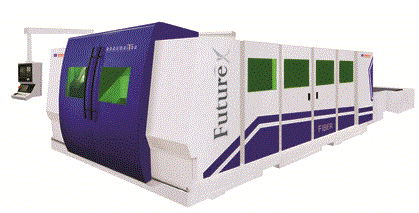 |
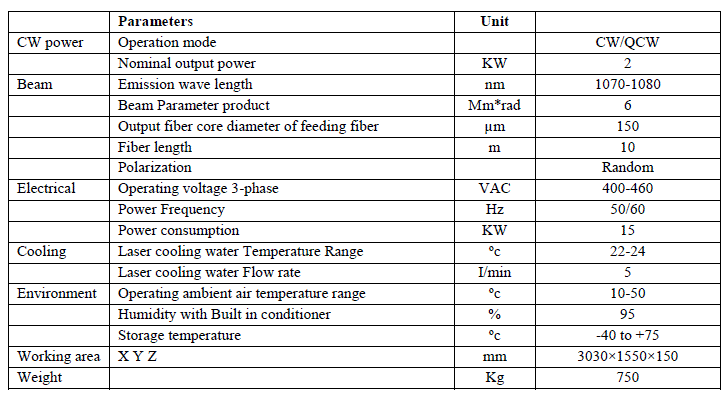 |
PLASMA DETECTOR SENSOR |
| In this paper the cutting speed is decided by plasma detector sensor as plasma formation starts cutting speed reduces we consider it as maximum cutting speed. The cutting speed is predetermined in sensor. Machining condition changing means for changing to decrease feeding speed as output of laser beam radiation which is instructed by said machining program. When said plasma detection judging means outputs result judged that said plasma was detected. [5] |
 |
PARAMETERS CONSIDERED FOR EXPERIMENT |
| 4.1 Input parameters |
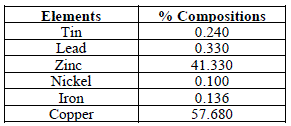 |
| Gas pressure is constant at oxygen 7 bar for all runs and all other parameters are constant. Focus position on the surface (0.0mm). |
| 4.2 Output parameters |
| Here main output parameter is surface roughness(μm) and cutting speed ,as cutting speed (mm/min)value is predetermined in the sensor for plasma formation but we take it before the formation of plasma so surface roughness is remain in acceptable rangeq |
EXPERIMENTAL TABLE |
 |
RESULTS AND DISCUSSION |
| As per ANOVA Analysis we can find the percentage contribution of input parameters for Surface Roughness as shown in below Table- 6. |
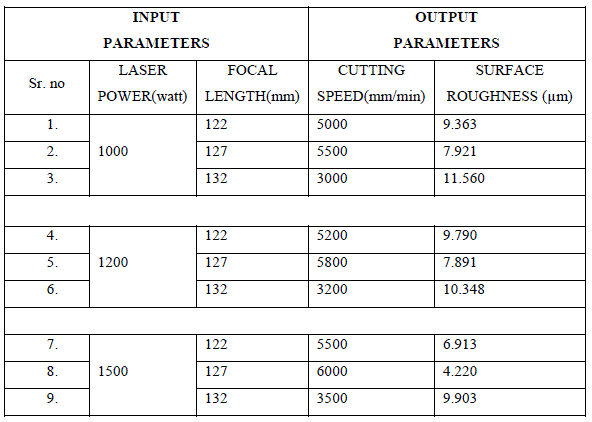 |
| After the manual calculations table we obtained 7 % error in brass (O2) for surface roughness shown in table 6, but if we consider interaction effect of both the parameters A & B than pure error comes to 0. This has been done using design expert software shown in table 7. |
 |
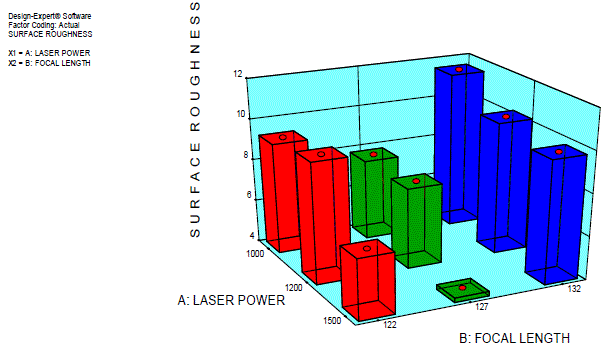 |
RESULTS AND DISCUSSION |
| From figure 2 as the Laser Power is 1000 Watts the focal length is increases from 122 to 132 then the Surface Roughness is increases from 9.363 μm, 7.921 μm and 8.929 μm. Cutting speed is decreases 5000 to 3000 mm/min with increases focal length.Similarly, for the Laser Power is taken 1200 Watts then Surface Roughness is 9.790 μm, 7.891 μm & 10.348 μm and the cutting speed decreases 5200 to 3200 mm/min with increases in focal length. The Laser Power is taken 1500 Watts the focal length increases 122 to 132 mm then Surface Roughness is 6.913 μm, 4.220 μm & 9.903 μm. Cutting speed is decreases 5500 to 3500 mm/min with increases focal length. |
CONCLUSION |
| The effects of focal length and Laser Power on quality characteristics of laser cut brass specimens have been studied in this work. As per ANOVA we can found that the Factor 2 –focal length is most significant factor for Surface Roughness of brass 1 mm thin sheet. Improper focal length affects the surface roughness and cutting speed. Results revealed that good quality cuts can be produced in brass sheets, at a window of laser cutting speed 6000 mm/min and at a power of 1500 Watts surface is 4.220 μm |
References |
|